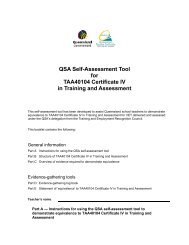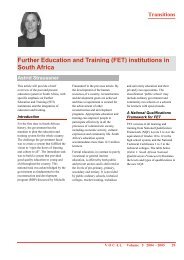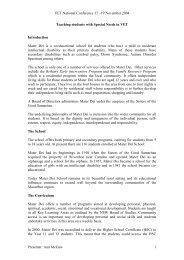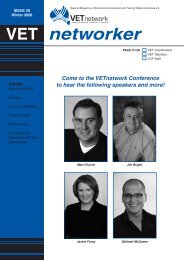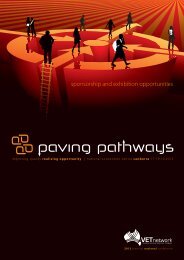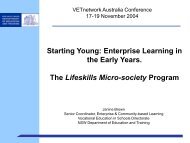WorkReady NT Program - VETnetwork Australia
WorkReady NT Program - VETnetwork Australia
WorkReady NT Program - VETnetwork Australia
- No tags were found...
You also want an ePaper? Increase the reach of your titles
YUMPU automatically turns print PDFs into web optimized ePapers that Google loves.
<strong>WorkReady</strong> in DARWIN
The Northern Territory:the last . . .. . . Frontier
WildVast &
SpotsTourist
Indigenous Art
Darwin – Cyclone Tracy 1974
TodayDarwin
Building Boom
LPG GasBorder Security
Tourist Boom“The Ghan”
Mindil Beach – a “must see”
Content• Our Place– The Territory– The Town• <strong>WorkReady</strong>– Objectives– Background & Context– Stakeholders– Goals & Strategies– <strong>Program</strong> Outlines– Management– The Future• Sanderson High– The Students– The Opportunities– The Process– The Story– The Results
<strong>WorkReady</strong> <strong>Program</strong>• Winner 2006 <strong>NT</strong> VET in SchoolsExcellence Award• Highly Commended Group Training<strong>Australia</strong> Partnership Award 2006
<strong>WorkReady</strong> <strong>Program</strong>OBJECTIVES• To increase the number of <strong>WorkReady</strong> programs in <strong>NT</strong>High Schools whilst offering flexible curriculum forstudents who want to pursue a vocational trainingpathway to employment.• To increase the number of School Based Apprenticeshipsin the <strong>NT</strong>, particularly in identified skill shortage areas.
<strong>WorkReady</strong> <strong>Program</strong>BACKGROUND• In 2002 Group Training <strong>NT</strong> and DEET established theSchool Based Apprenticeship <strong>Program</strong> in the Darwinregion.• The program was introduced into Darwin High Schoolsas part of the VET Wednesday program which allowedthe students to work only one day a week.
VET Welding
<strong>WorkReady</strong> <strong>Program</strong>BACKGROUND (continued)• In 2004 Group Training <strong>NT</strong> conducted a feasibility studyin Darwin to determine if schools would consider pilotingthe <strong>WorkReady</strong> <strong>Program</strong>.• Sanderson and Palmerston High Schools agreed to pilotthe program in 2005. Both programs commenced with25 students who were keen to enter a School BasedApprenticeship (SBA).
Rob: School Based Apprenticeship,Manager <strong>NT</strong>
<strong>WorkReady</strong> <strong>Program</strong>CO<strong>NT</strong>EXT• A formal Memorandum of Understanding (MOU) hasbeen established between the schools, DEET and GroupTraining <strong>NT</strong> (GT<strong>NT</strong>).• The MOU outlines the roles and responsibilities of thepartners. It also includes very specific student targets,outcomes and stakeholder deliverables.
<strong>WorkReady</strong> <strong>Program</strong>CO<strong>NT</strong>EXT (continued)• A Professional Learning Community (PLC) has beenestablished for schools across the Northern Territory tosupport the <strong>WorkReady</strong> <strong>Program</strong>.• The PLC is for teachers of the <strong>WorkReady</strong> <strong>Program</strong> todevelop and share approaches using flexible delivery tosenior school students. It will develop a commonapproach to school to work transition for identifiedvocational student groups.
Field Officers: Tammy & Angela
<strong>WorkReady</strong> <strong>Program</strong>STAKEHOLDERS• Students• Parents• Employers (host) / Peak Industry Organisations• Group Training <strong>NT</strong>• DEET Senior Secondary Schools• DEET Employment and Training Division• DEET Curriculum Services• Training Advisory Councils• Local Community Partnership
<strong>WorkReady</strong> <strong>Program</strong>GOALS• Students are willing and committed program participants.• Participants are work ready when they commence a SBA,with appropriate standards in numeracy and literacy.• Participants have a work ready aptitude when theycommence a SBA, with an appreciation of timeliness,presentation and willingness.
Suzi: former Apprentice, nowAdministration Officer
<strong>WorkReady</strong> <strong>Program</strong>STRATEGIES• GT<strong>NT</strong> provides assistance in the transition from school towork to 100 students, from four High Schools, who wantto pursue a vocational training pathway to employment.• GT<strong>NT</strong> delivers a two day work preparation workshop forYear 10 students to prepare resumes, improve jobinterview skills and research apprenticeships.• YouthworX <strong>NT</strong> (LCP) provides work placements for Year10 and 11 students who have indicated they would liketo pursue a School Based Apprenticeship opportunity.
Nadia: Apprentice at GT<strong>NT</strong>
<strong>WorkReady</strong> <strong>Program</strong>PROGRAM OUTLINE YEAR 10• Information sessions for students and parents• Prepare expressions of interest and resumes• Interview with students and parents• Work preparation program for 2 days• Work placement for 1 week• Student applies for VET in Schools <strong>Program</strong>
Michael at School Based ApprenticeshipTransport & Distribution
<strong>WorkReady</strong> <strong>Program</strong>PROGRAM OUTLINE YEAR 11• <strong>NT</strong>CE school subjects (two days)• VET in Schools <strong>Program</strong> with work placement• Senior First Aid• Certificate II or III in SBA• DTAL (Driver Training <strong>Program</strong>)• Case management of students
Joseph atSchool Based Apprenticeship
<strong>WorkReady</strong> <strong>Program</strong>PROGRAM OUTLINE YEAR 12• Students in SBA• Certificate II or III• <strong>NT</strong>CE school subjects (two days)• Case management of students• DTAL• Senior First Aid
Toni-Lee atSchool Based Apprentice
<strong>WorkReady</strong> <strong>Program</strong>MANAGEME<strong>NT</strong>• A management committee consisting of schoolprincipals, DEET representatives and Group Training <strong>NT</strong>meet quarterly to assess the progress of the programand review the targeted student outcomes.• Successful outcomes include students moving into fulltime employment, further education and training orcontinuation of an apprenticeship.
Wayne at School Based ApprenticeshipRefrigeration
<strong>WorkReady</strong> <strong>Program</strong>PRESE<strong>NT</strong> & FUTURE• The future of the <strong>WorkReady</strong> <strong>Program</strong>s in the Darwinregion is very positive. There are currently four DarwinHigh Schools that have implemented the <strong>WorkReady</strong><strong>Program</strong>.• A further two schools will establish programs in 2007,which will make six schools in total for Darwin.• DEET Initiative: Middle Schools / Senior Schools
<strong>WorkReady</strong> <strong>Program</strong>PRESE<strong>NT</strong> & FUTURE (continued)• Darwin will have an <strong>Australia</strong>n Technical College in 2007.The ATC will be a virtual college, and schools with<strong>WorkReady</strong> <strong>Program</strong>s will be identified as dualenrolments to feed the ATC.• The <strong>WorkReady</strong> program is a win, win, win situation forall stakeholders, including students, parents, schools andlocal business and industry.
Jared at School Based ApprenticeshipConstruction
Bevan at VET Automotive Training
<strong>WorkReady</strong> <strong>Program</strong>“School Based Apprenticeshipsare great because they areflexible and offer manyopportunities and choices tostudents.”
National Excellence inTeaching Award 1994,QueenslandWORKREADYatSanderson High School (SHS(SHS)
SHS – The Students• Student composition– Approximately 550 students– Over 30 different cultures– English is often 2 nd , 3 rd , 4 th language• Socio-economics– typically low income & single-parent family– high unemployment– dole is an expectation of entitlement rather than a safety net• Attitudes– expectations are low, regular attendance is a challenge– boredom, disinterest and low self-esteem esteem are prevalent issues– many express the belief that anything is better than schoolSummary: the school probably represents the only stabilitymany of these students have in their lives
SHS – Innovative Options• Pastoral Care (the school promotes Restorative Justice principles)• Vertical time-tablingtabling (allows students to progress according to individual readinessrather than chronological age)• Groups (Nomads, Girls Group, Boys Group) for students at risk• Targeted intervention programs (e.g. Accelerated Literacy)• VET <strong>Program</strong>s<strong>Program</strong>s (e.g. Cert I in Hospitality; other VET programs are offered as part pofcluster arrangement with other schools & Registered Training Organizations such as CharlesDarwin University)• Work Experience (offered to all students from Year 9 onwards)• Exposure to industry (e.g. Futures Expo, Try-a-Trade, Trade, Adopt-a-School)• Compacted Curriculum with <strong>WorkReady</strong> <strong>Program</strong> (common sense,practical and contextualised approach to learning, vectored towards gaining anapprenticeship and future employment)
SHS – Compacted CurriculumThis approach has been piloted in 2004.Advantages:• Working with one teacher results in students– taking ownership of a room that is “theirs”.– building a closer relationship with their main class teacher.– experiencing less disruption to their learning as they arenot taken out of other classes.• Flexibility allows students to– engage simultaneously in academicand workplace learning.– complete their Year 11 and 12 studies (<strong>NT</strong>CE) whilstenrolled in a School Based Apprenticeship.
SHS – Compacted Curriculum (cont.)Results at the end of the year were very impressive:• retention levels increased,• attendance improved dramatically, and• many students attained the required 12 units at Stage 1.@Direct consequence:• Meeting with Bob Chapman from Group Training <strong>NT</strong>• Discussing traineeship/apprenticeship options for students• Decision to pilot Pathways (now <strong>WorkReady</strong>) ) in 2005
SHS – <strong>WorkReady</strong>: Organisation• Students attend school two dayseach week for regular lessons viathe Compacted Curriculum model• Students go to VET classeseach Wednesday• Students spend two days each weekin a workplace environment
SHS – <strong>WorkReady</strong>: ManagementThe School Management Group consists of• a Teacher who provides academic input & supportaccording to the Compacted Curriculum model• a Careers Counsellor who develops the Learning<strong>WorkReady</strong> Plans in consultation with the students• a VET Co-ordinatorordinator who, in collaboration with theCareers Counsellor, maps and monitors theeducation and training outcomes, ensuring thecorrect patterns are maintained to satisfy <strong>NT</strong>CErequirements
SHS – <strong>WorkReady</strong>: Management (cont.)• AIEW and ISA provide additional supportfor indigenous students• Group Training <strong>NT</strong> offer professionaladvice and help to find suitable workplacements for studentsStudents are individually case-managed. . The team meets regularlyto assess, monitor and makerecommendations to ensure required<strong>NT</strong>CE patterns are met.
SHS – <strong>WorkReady</strong>: ExpectationsWe believe that as a direct outcome of this type ofcontextualised learning our students will• increase their work skills and improve their self-esteem.esteem.• attain the <strong>NT</strong>CE and acquire income.• gain employment in industries with skills shortages.This will improve opportunities for• Indigenous students,• girls, and• students at risk.
SHS – <strong>WorkReady</strong>: Evidence - PilotNUMBERS Year End 2005543210Full Time ApprenticeshipsSchool Based ApprenticeshipsWork PlacementsStudent Services ClientsNot w ork ready yetThis graph represents students in the first year of their <strong>WorkReady</strong> <strong>Program</strong>.
SHS – <strong>WorkReady</strong>: Evidence - Current• Our students attend VET classes and Apprenticeshipsor Traineeships in the following areas:– Tourism, Parks & Wildlife,– Hospitality & Catering,– Metals & Engineering,– Sports & Recreation,– Design & Fashion,– Horticulture,– Automotive,– Clerical,– Retail,– Aeronautics, and– Electro-Technology
SHS – <strong>WorkReady</strong>: Evidence - 2006NUMBERS Term 3 20061086420Full Time ApprenticeshipsSchool Based ApprenticeshipsWork PlacementsStudent Services ClientsNot w ork ready yetThis graph represents students in the first & second year of their <strong>WorkReady</strong> <strong>Program</strong>.
SHS – <strong>WorkReady</strong>: Evidence - Results• Every student enrolled in their second year in theprogram is in a School Based Apprenticeship• Some students have already left as they haveaccepted full-timeapprenticeships• One student has been the winner of the DEETNorthern Territory Training Award• One student has been nominated for the DESTSchool Based Apprenticeships Award
DEET Northern Territory TrainingAward Winner 2006Amina SherifCertificate II Clothing Production
DEST School Based ApprenticeshipAward Finalist 2006Kane MolaCertificate II Hospitality





